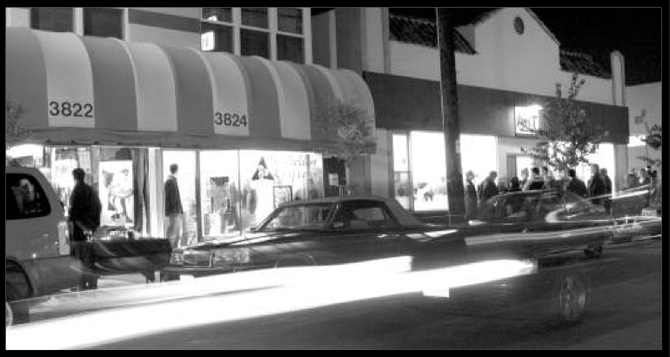 Facebook
Facebook
 X
X
 Instagram
Instagram
 TikTok
TikTok
 Youtube
Youtube

After 14 years of living in North Park, a marriage proposal propelled me into the arms of Encinitas. I've acclimated, but on evenings when I hear norteño music pulsating from the roadway behind my new home in the 'burbs, I become wistful thinking of my North Park neighborhood. I loved its sights, sounds, and people — like the New York City subways, an experiment in humanity.
My first memories of North Park were as a child of the '60s. Though we lived in Kensington, my folks would drive us over in the family Rambler to watch movies at the North Park Theater, skate at the roller rink, and shop at the boutiques lining University Avenue. My mother loved the JCPenney (now Big Lots), which was the company's flagship store in San Diego. A treat was a trip to the Jewish bakery on 30th Street.
When I bought my tiny Craftsman bungalow in the late 1980s, North Park had become a different place. Friends worried whether it was safe, a concern furthered by news stories of drive-by shootings. As a defense mechanism, I claimed I lived in "the 'hood." Living blocks from the Balboa golf course and steps from Switzer Canyon, how could this be a bad thing? And on a clear day, motoring down the eastern edge of Balboa Park on Pershing Drive, you can see forever.
Years of neglect, bad zoning laws, and awful remodeling jobs took their toll, but people awakened to North Park's inventory of early 20th-century architecture. Owning a vintage home has become a status symbol and a rallying point for preserving the character of the community. North Park is being transformed by the influence of the creative class. Many artists moved into North Park's business district after being displaced by the ballpark.
I now live in a half-million-dollar stuccoid home — a "modest" 1600 square feet — in new Encinitas. We have central heating and air-conditioning, and many electrical outlets. Nevertheless, my favorite memory of North Park remains those balmy evenings when my underinsulated, un-air-conditioned ancient home was so hot inside that all I could think of was to grab an icy glass of lemonade and sit on the porch. And it would be so hot in every house on the block that all my neighbors would be rustling about outside. One thing would lead to another, and we'd end up having a party in a neighbor's back yard. We'd swap stories about skunks and possums appearing in the kitchen, eating the cat food. Or we'd discuss home-restoration tips and real estate prices in North Park — $350,000 for a 700-square-foot cottage? We'd pass along gossip, debate politics, and, underlying everything, share a feeling that we were living in the coolest, most happening neighborhood in all of San Diego. I miss that feeling.


After 14 years of living in North Park, a marriage proposal propelled me into the arms of Encinitas. I've acclimated, but on evenings when I hear norteño music pulsating from the roadway behind my new home in the 'burbs, I become wistful thinking of my North Park neighborhood. I loved its sights, sounds, and people — like the New York City subways, an experiment in humanity.
My first memories of North Park were as a child of the '60s. Though we lived in Kensington, my folks would drive us over in the family Rambler to watch movies at the North Park Theater, skate at the roller rink, and shop at the boutiques lining University Avenue. My mother loved the JCPenney (now Big Lots), which was the company's flagship store in San Diego. A treat was a trip to the Jewish bakery on 30th Street.
When I bought my tiny Craftsman bungalow in the late 1980s, North Park had become a different place. Friends worried whether it was safe, a concern furthered by news stories of drive-by shootings. As a defense mechanism, I claimed I lived in "the 'hood." Living blocks from the Balboa golf course and steps from Switzer Canyon, how could this be a bad thing? And on a clear day, motoring down the eastern edge of Balboa Park on Pershing Drive, you can see forever.
Years of neglect, bad zoning laws, and awful remodeling jobs took their toll, but people awakened to North Park's inventory of early 20th-century architecture. Owning a vintage home has become a status symbol and a rallying point for preserving the character of the community. North Park is being transformed by the influence of the creative class. Many artists moved into North Park's business district after being displaced by the ballpark.
I now live in a half-million-dollar stuccoid home — a "modest" 1600 square feet — in new Encinitas. We have central heating and air-conditioning, and many electrical outlets. Nevertheless, my favorite memory of North Park remains those balmy evenings when my underinsulated, un-air-conditioned ancient home was so hot inside that all I could think of was to grab an icy glass of lemonade and sit on the porch. And it would be so hot in every house on the block that all my neighbors would be rustling about outside. One thing would lead to another, and we'd end up having a party in a neighbor's back yard. We'd swap stories about skunks and possums appearing in the kitchen, eating the cat food. Or we'd discuss home-restoration tips and real estate prices in North Park — $350,000 for a 700-square-foot cottage? We'd pass along gossip, debate politics, and, underlying everything, share a feeling that we were living in the coolest, most happening neighborhood in all of San Diego. I miss that feeling.
Comments